As some of you might have noticed, it was Wikipedia’s birthday a week and a half ago. Ten years since Jimmy Wales and Larry Sanger had the unlikely idea that letting the public write their own encyclopaedia might produce anything other than garbage, and were so taken with the notion that they actually made it happen. It took just 3 years for Wikipedia to become the biggest encyclopaedia. By its seventh birthday Wikipedia had broken into the top ten websites in the whole world. There are now 17 million articles in hundreds of languages – the English Wikipedia alone has 3.5 million articles. And it’s still a charity, running no ads (except the yearly fundraiser) and employing a tiny staff. The bulk of the work is done, as it always has been, by volunteers.
And when people say Wikipedia is free, they don’t just mean it’s free to read. It’s free to use to. You can cut and paste an entire article into your blog, without asking permission, so long as you credit the source and allow others to do the same. You could even copy the whole damn thing onto your own servers and charge people to read it, if you wanted to (good luck finding anyone willing to pay, though).It’s all part of a movement to make media more freely available both for consumers and people who want to create as well.
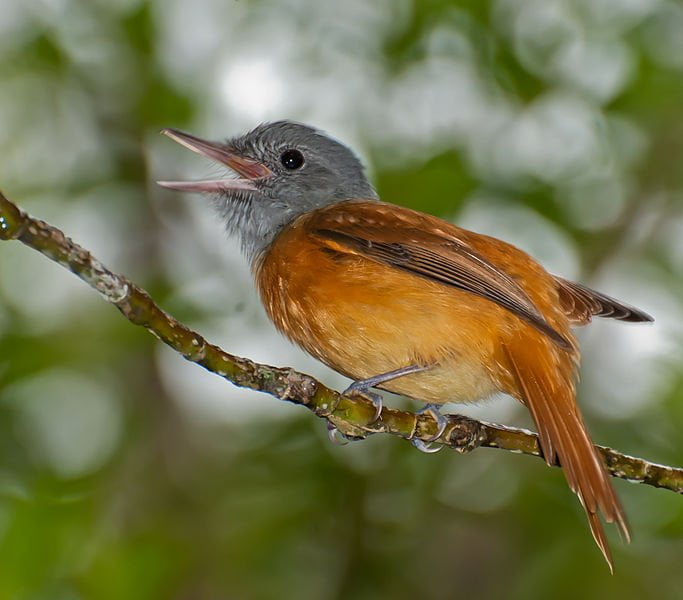 This photo of a Grey-hooded Attila was released on a Creative Commons Share-alike 2.0 Licence by Flickr User Dario Sanchez. This allows Wikipedia to use it to illustrate the article on the species, and me to use it here, and you to use it for what you wish to do so, so long as you allow future creators the same rights.
This photo of a Grey-hooded Attila was released on a Creative Commons Share-alike 2.0 Licence by Flickr User Dario Sanchez. This allows Wikipedia to use it to illustrate the article on the species, and me to use it here, and you to use it for what you wish to do so, so long as you allow future creators the same rights.
At this point you might be forgiven for asking “What does this have to do with birds?” The answer is “quite a bit”. Wikipedia covers everything. And birds do fall somewhere within the realm of everything (possibly between the vacuum cleaners and Persian literature). People have applied the same principals to Wikipedia in general to the coverage of birds specifically. To this end every species (depending on what you consider a species), every genus (depending on what you consider a genus), every family (depending on… okay you get the idea), every order, and quite a few of the more obscure taxons all have articles. But it goes beyond this. There is an article on, specifically, Black-necked Cranes in Bhutan. And the extinct fossil parrot with the inspired name Vini vidivici. And the endemic birds of the Andaman and Nicobar Island,the West Pacific Flyway, a carrier pigeon called Paddy and petrel stomach oil. Overseeing the ever expanding collection of articles on birds is a internal group, called Wikiproject:Birds, of which I am personally a member.
It’s because of this, in fact, that I ended up here on 10,000 Birds, inflicting my New Zealand related posts on you all on a weekly basis (assuming any of you read them). I had contacted 10,000 Birds in order to see if I could have the team write something about WikiProject:Birds. Charlie, who responded, asked what a blog could or should be expected to do for a behemoth like Wikipedia (as Charlie relates here in what would be my first post). The question is not unfair, Wikipedia is indeed huge and popular.
The answer is, it needs help because it is huge and popular. Type “bird” into Google. Go on, I’ll still be here. The first result you get? Wikipedia’s article on birds. Now try “eagle”, “cockatoo”, “Peregrine Falcon”… I’m sure you can see where I’m going with this. Fairly or not, Wikipedia articles tend to score highly on Google Searches. This means that interested parties will quickly encounter Wikipedia articles. If someone is interested in a bird, chances are they’ll end up on Wikipedia to learn about it. Which is great, except there aren’t enough editors to keep up. I don’t wish to belittle the efforts of my fellow editors, who churn out astonishing amounts of great writing. But there is simply too much to do. And that means someone interested in Kakapo would get a great article, but someone interested in quails might end up at this article.
It doesn’t take much effort to edit Wikipedia. Lets take a quick look at the article on fire-eyes, a small genus of antbird from South America. The article is pretty basic, actually.
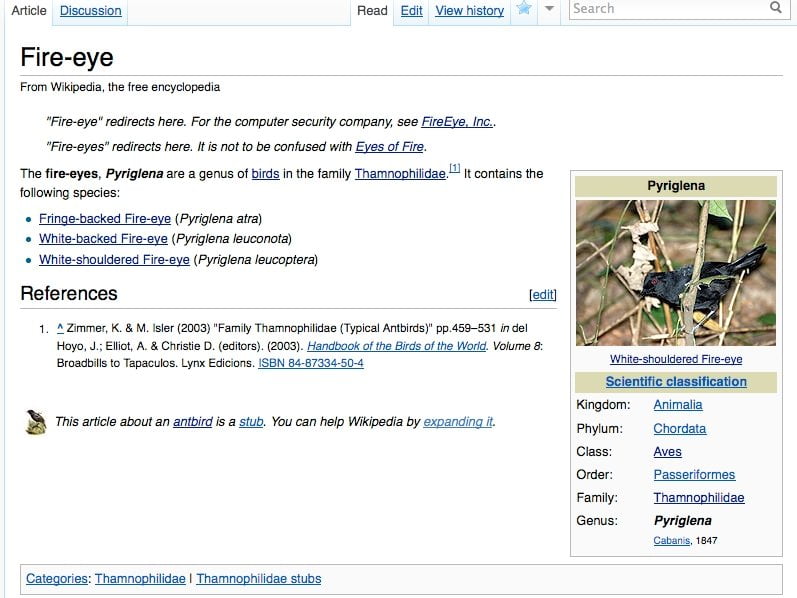 A list of species, a single line about the species, some links at the top for other meanings of the word, and a box with taxanomic information and a photo (called a taxobox, obviously). This clearly needs some improving. At the top right there’s a button saying edit. Let’s click it…
A list of species, a single line about the species, some links at the top for other meanings of the word, and a box with taxanomic information and a photo (called a taxobox, obviously). This clearly needs some improving. At the top right there’s a button saying edit. Let’s click it…
Okay, calm down, it isn’t that bad. The top bits are the coding (called a template) for the taxobox, and you don’t have to touch that. The important bit is in the middle, where you can see the actual text of the article. Not that there is much there. So while I add some information, take a few seconds to learn the only code you’ll need to know to edit Wikipedia.
First off are the links. Wikipedia’s addictive quality for many people is the ability to jump from article to article. These jumps are powered by internal links, and linking between articles could not be simpler. Say you want to link to the article South America because that is where fire-eyes live. So in the sentence of this, put South America inside paired [[ ]] – like [[South America]]. That’s it! It’s linked. It is a tiny bit more complicated if the article you link to has a different name to how you want to phrase it – for example you want to say “they are sexually dimorphic” but the article is at sexual dimorphism. Then you code it [[sexual dimorphism|sexually dimorphic]] – destination article | what you want to see.
That is pretty much it. If you want to created a new section header put the title of the section in equal signs like this…
==Species list==
And if you want italics surround the word or phrase with dual apostrophes – like ”Homo sapiens”. And that is really all there is to it. Lets check the code quickly now that I have added some facts.
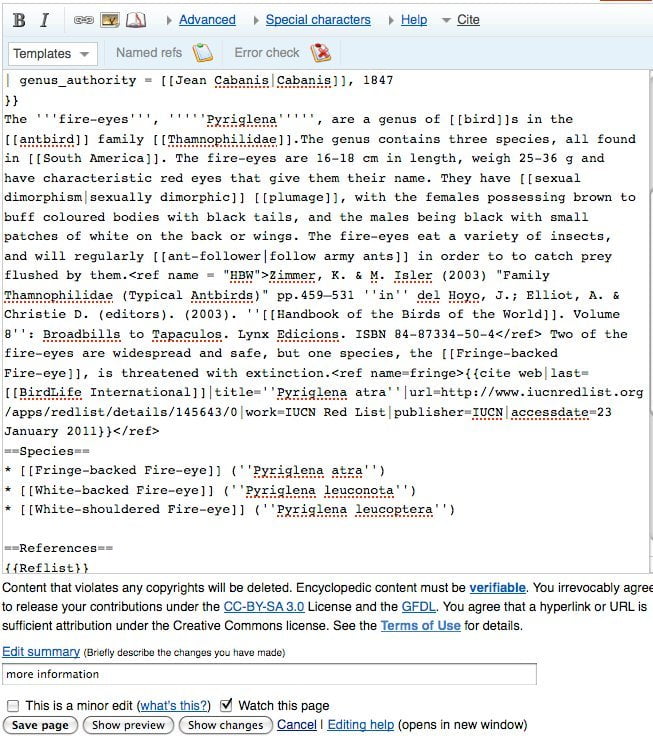 You might notice there are some code-y looking templates in the middle of the article as well. These are called citation templates, bt again, don’t panic! They are created by clicking the link called template, then picking the type of source you have. A simple fill in menu allows you to type in various bits of your source (year, author, title, that kind of thing). Then you click insert and ta-da! The horrible code is created for you without you having to do a thing. Anyway, lets click save page and look at the newly improved article.
You might notice there are some code-y looking templates in the middle of the article as well. These are called citation templates, bt again, don’t panic! They are created by clicking the link called template, then picking the type of source you have. A simple fill in menu allows you to type in various bits of your source (year, author, title, that kind of thing). Then you click insert and ta-da! The horrible code is created for you without you having to do a thing. Anyway, lets click save page and look at the newly improved article.
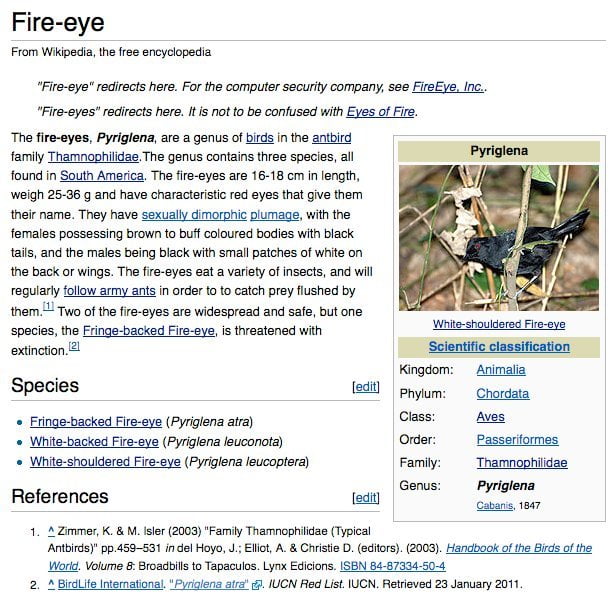 It’s still pretty short, but it is more informative than a single line. Given that fire-eyes are ant-followers a great deal more could be written about them, and one day I’ll get around to them. So many birds, so little time.
It’s still pretty short, but it is more informative than a single line. Given that fire-eyes are ant-followers a great deal more could be written about them, and one day I’ll get around to them. So many birds, so little time.
So now it’s time for homework. What, didn’t I tell you there’d be homework? Sorry! But this isn’t onerous, I promise. It’s just a chance to wish Wikipedia a happy birthday by helping one of its articles. And an article that is important to 10,000 Birds as well, Sharpe’s Longclaw.
It’s a pretty short article, three short lines, no photos, and a great deal more could be written about it! Perhaps if you have a copy of “Who’s Bird?” you could tell the world who the Sharpe who was honoured in the name was. Or use BirdLife’s page to fill in more details about its biology. Or even use 10,000 Birds’ coverage to help you. So go add something, even just a line, to try and make it a little better. Don’t worry about messing it up, no change can’t be fixed (I can offer help on my user page). Perhaps if your favourite bird is barely more than a few lines you could help that article as well? Just a line here or there? If you do, leave a comment telling us what you did!
Wikipedia works because people care, care about information being available to all. Every single one of its millions of articles is a testament to people writing and sharing. Long may it continue.
*Resources and links
There Is a great deal more to say about Wikipedia than I can cram into a single blog posting. This link here serves as a more overall introduction and has a tutorial if you’d like to learn more about editing before you dive in.
Perhaps you’ve got an image you’d like to donate? We still have thousands of species and even a few families, without images, and we always welcome more. The relevant information about uploading images is here.
The Bird Wikiproject welcomes more than just article writers. We have regular discussions on all the aspects of working and pulling everything together. This includes discussions on taxonomy (we are discussing the family limits of the suboscine passerines at the moment, amongst other things). We also have an ongoing effort to identify the species of bird in pictures donated to us!
Be sure to comment if you have any question!


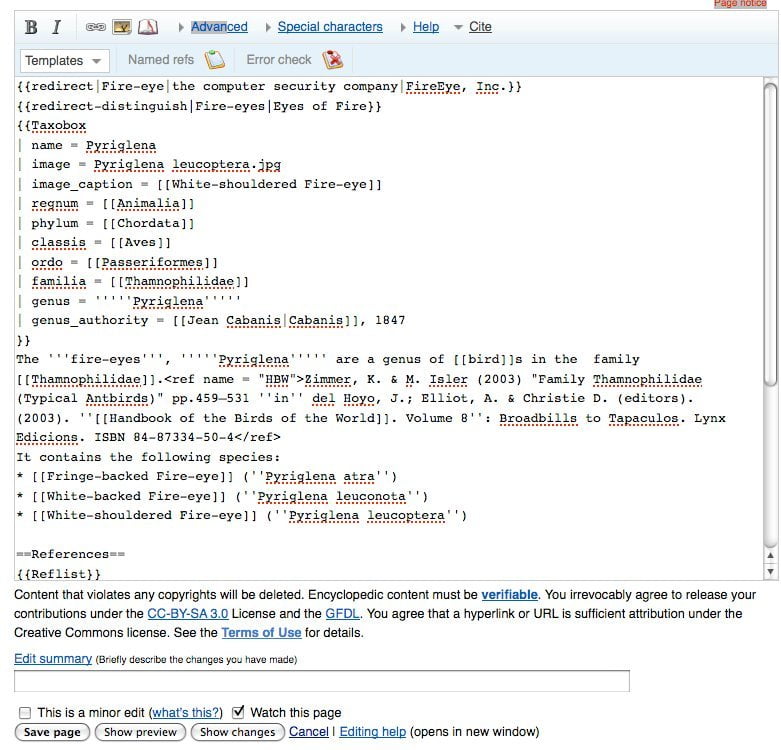
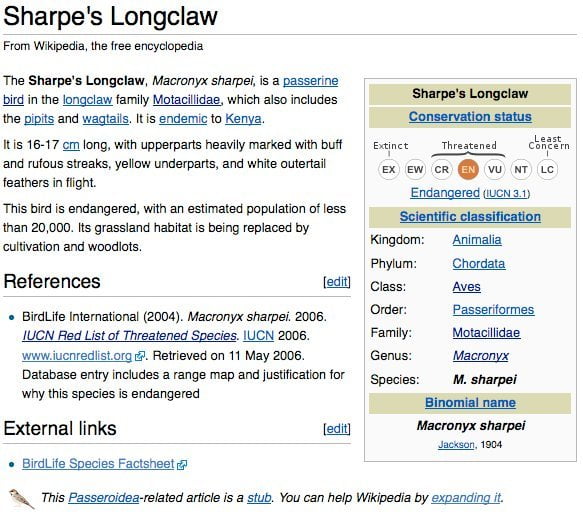











Duncan, thanks – this is a great opportunity to get more online about the Sharpe’s Longclaw (and having said that I suppose I’m the person who needs to contribute the info eh?). Will do…
I’ve taken a couple of bird articles from ‘stub’ to ‘good article’ eg http://en.wikipedia.org/wiki/Black-shouldered_Kite
Obe criticism of Wikipedia is that it does not recognise ‘experts’ in a subject area – everything must be referenced, so if you know something from years of direct study you can’t contribute that information.
@ Charlie – I hope lots of people will help, but your knowledge is especially welcome!
@Marj – While I agree the policy on personal knowledge is annoying I can see the need. Allowing everyone to contribute “their knowledge” unverified is a non-starter, and the setting up verified “expert status” accounts will rub most editors up the wrong way.
I don’t find the policy annoying – just something to be aware of. For many birders their knowledge of a species comes from many years of direct observation – not from reading books about them – but that knowledge can’t be used by wikipedia for the reasons you give.
I agree that the policy is vital. I guess that any knowledge derived from personal observations should be published anyway to make it accessible to other/future researchers (“citizen” and professionals alike), and this would make it acceptable for inclusion into wikipedia.
now that was an incredible article. I went through a stage when I put a bit of effort in to writing wikipedia and birdforum opus articles. it was loads of fun and somehow gratifying to contribute to the sharing of knowledge.
Wikipepedia has been very useful, I would suggest more up-to-date information to be added as we improve science wise.
thank you
Dominic